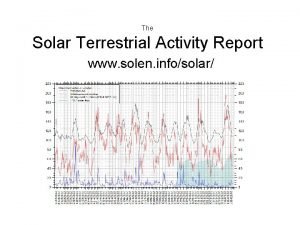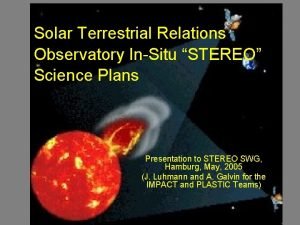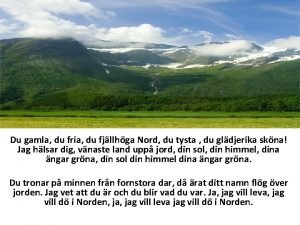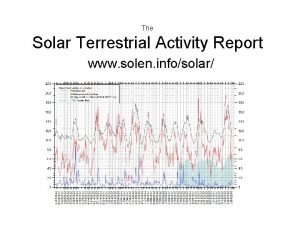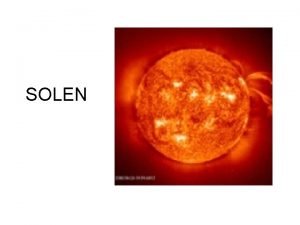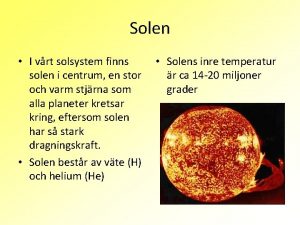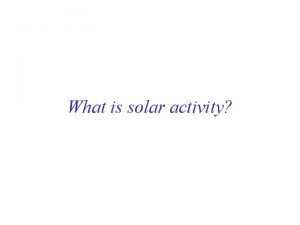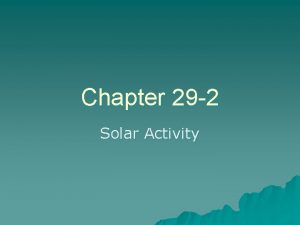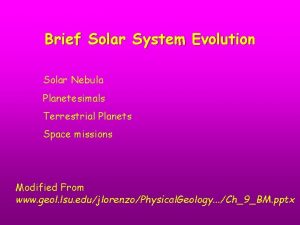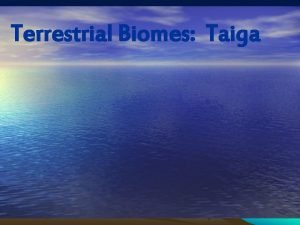The Solar Terrestrial Activity Report www solen infosolar











- Slides: 11

The Solar Terrestrial Activity Report www. solen. info/solar/

History • • ~1995 – monthly report (paper) 1997 – daily reports (Internet) 2002 – detailed sunspot analysis 2002 – archive of daily reports 2002 – Coronal hole numbering and archive 2010 – Switch from SOHO to SDO as image source 2010 – Sunspot number using 2 K SDO continuum images • 2011 – Sunspot analysis using polarity overlays • 2012 – Added 1 K SDO sunspot number. Sunspot image documentation at 1, 2 and 4 K resolution

Coronal holes • Visible disk observations • Inferred (behind the limbs)

Sunspots – image creation • Using magnetic overlays greatly aids spot analysis – both at the overview and detailed level + = The transformation from 2 images to the magnetic overlay image only requires a few steps. Easily done in Gimp or Photoshop

Sunspots – magnetic deltas • Quickly detect magnetic delta structures AR 11515 developed many magnetic delta structures in early July 2012 AR 11515 produced 1 X and 6 M class flares on July 6

Sunspots – group boundaries • Using magnetic boundaries instead of longitudinal separation when determining possible splits Magnetically one group Locarno split into 2 groups (77/78), presumably because of longitudinal separation of spots, see http: //www. specola. ch/drawings/20 12/loc-d 20120326. JPG

Sunspots – early detection • Early detection improves quality of related solar data NOAA recorded a C 5. 8 flare at 17: 07 UTC on January 18 and attributed it to AR 11654. SDO/EVE SAM confirms that the flare occurred in AR S 2181 (now 11660)

Sunspots – high latitude obs. AR S 2052, location: N 42 E 30 Easily observed in 1 K resolution on Nov. 14, 2012 AR S 1968, location: N 51 E 04 Poorly defined spot, observed in 2 K on October 8, 2012 AR S 1578, location: S 41 E 22 Several spots in 2 K, one in 1 K resolution. Observed on April 10, 2012

Solar cycle charts Comparison with similar cycles Cycle 24 progress, current status Smoothed max in Feb. ’ 12: 66. 9 NH smoothed max in Sept. ’ 11: 41. 3 SH smoothed max in April ’ 12: 30. 1

Performance of STAR-SDO sunspot numbers in 2012 • Similar development as SIDC and NOAA

Monthly K factors in 2012 • Peak in March for STAR-SDO and NOAA
 Solen.info solar
Solen.info solar Solar terrestrial relations observatory
Solar terrestrial relations observatory Whosale solar
Whosale solar Inexhaustible source of energy
Inexhaustible source of energy Jørgen gleerup
Jørgen gleerup Se, nu stiger solen tekst
Se, nu stiger solen tekst Nu rinder solen op af østerlide
Nu rinder solen op af østerlide Sommarlov solen lyser skönt
Sommarlov solen lyser skönt Nu löser solen sitt blonda hår analys
Nu löser solen sitt blonda hår analys I østen stiger solen op tekst
I østen stiger solen op tekst Rocky planet surface
Rocky planet surface Length of orbit on saturn
Length of orbit on saturn
